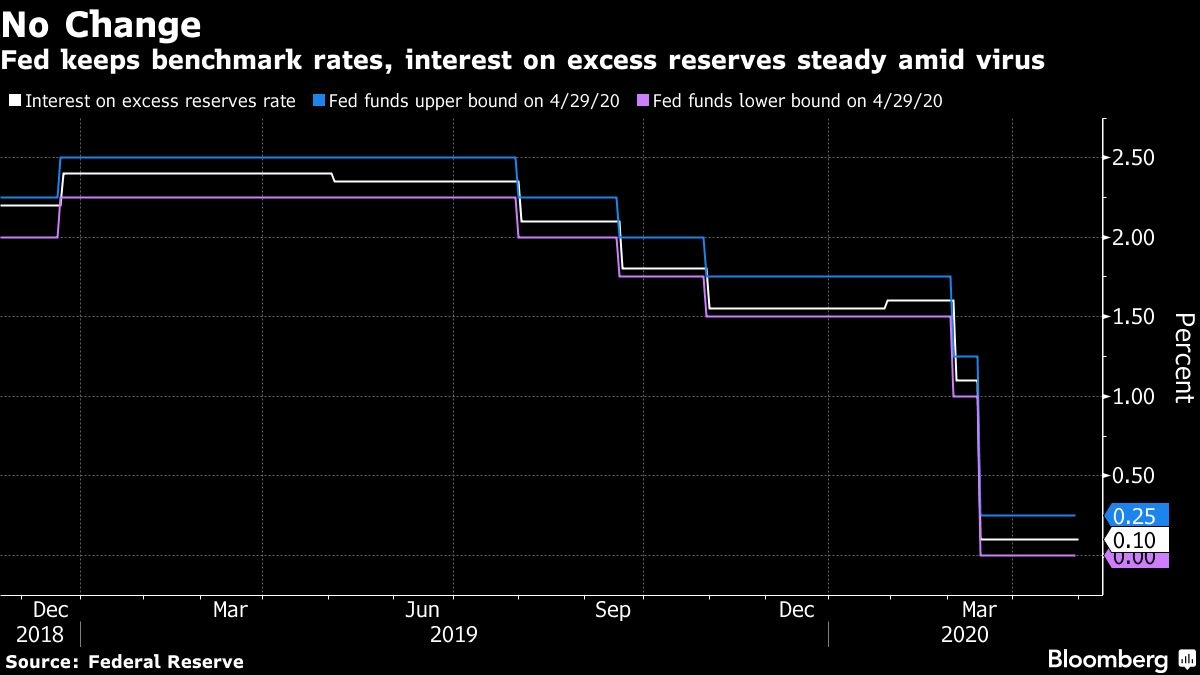Apr 29, 2020
Fed holds near-zero rate, Powell sees severe impact from pandemic
, Bloomberg News
Fed holds key rate, warns of severe virus impact
Federal Reserve Chairman Jerome Powell said the coronavirus has brought the economy to an “abrupt halt” and it was uncertain how long the slowdown would last, as officials held interest rates near zero — and pledged to keep them there until the nation was back on track.
“Economic activity will likely drop at an unprecedented rate in the second quarter,” Powell told a video press conference Wednesday. “It may well be the case that the economy will need more support from all of us, if the recovery is to be a robust one.”
The Federal Open Market Committee said in a unanimous statement that it “will use its tools and act as appropriate to support the economy” and cautioned the pandemic would weigh on the economy over the medium term.

U.S. stocks held gains after the Fed’s statement while yields on 10-year Treasury notes edged up slightly to 0.62 per cent.
Powell emphasized several times the importance of fiscal policy to help and said “this is not the time” to allow concerns about the size of the federal deficit to hinder the scale of the response.
Target Range
Officials Wednesday left unchanged their vague guidance on the future path of rates. The statement repeated language from March 15 saying the committee would keep the benchmark target range near zero “until it is confident that the economy has weathered recent events and is on track to achieve its maximum employment and price stability goals.”
“I think everyone is suffering here but I think those who are least able to bear it are the ones who are losing their jobs,” Powell said. “It is heartbreaking to see all that threatened right now.”
Time frame extended
Wednesday’s statement also acknowledged the extent and breadth of the damage being wraught by the ongoing contagion.
“The coronavirus outbreak is causing tremendous human and economic hardship across the United States and around the world,” the committee said. “The virus and the measures taken to protect public health are inducing sharp declines in economic activity and a surge in job losses.”
Regarding asset purchases, the FOMC used wording similar to last month, saying the buying of Treasuries and mortgage-backed securities will continue “in the amounts needed to support smooth market functioning, thereby fostering effective transmission of monetary policy to broader financial conditions.”
It made specific mention of lower oil prices and their role in holding down inflation.
Policy makers also began to extend cautiously the time frame within which they see the economic blow from the virus lasting, though they are still offering no precise forecast.
Medium Term
“The ongoing public health crisis will weigh heavily on economic activity, employment, and inflation in the near term, and poses considerable risks to the economic outlook over the medium term,” the committee said.
The central bank has mounted an unprecedented push to limit the economic harm of the virus, which has plunged the global economy into recession and likely sent U.S. unemployment well above 10 per cent after businesses shuttered to slow the contagion.
Government data released earlier on Wednesday showed U.S. gross domestic product shrank at an annualized 4.8 per cent rate in the first quarter, the largest drop since 2008. Economists surveyed by Bloomberg expect the central bank to keep rates near zero for three or more years.
Policy makers last month slashed their benchmark rate and launched a massive bond-buying campaign to stabilize markets for Treasury and mortgage-backed securities that had become dangerously unsettled amid the pandemic. The federal funds rate has stood in a range of zero to 0.25 per cent since mid-March.
The central bank’s Board of Governors has also responded to the crisis by announcing nine extraordinary lending programs, pledging to make funds available to banks, money market funds, companies, cities and states in an unprecedented use of the Fed’s emergency powers.
--With assistance from Catarina Saraiva


